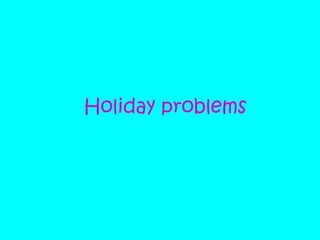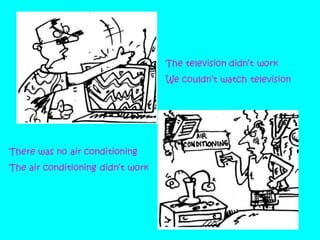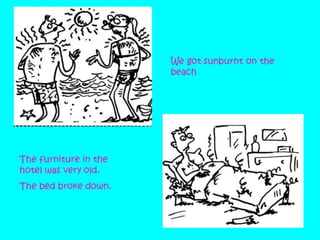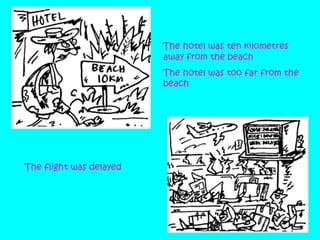1 of 9









Ad
Recommended
The Present Continuous Tense
The Present Continuous TenseIES Rosario de Acu├▒a
╠²
This document provides information and examples about using the present continuous tense in English. It discusses how the present continuous tense is formed affirmatively, interrogatively, and negatively. It also gives examples of when to use the present continuous tense, such as for actions happening at the present time, temporary situations, changing or developing situations, and fixed arrangements in the near future. Time expressions that can be used with the present continuous tense are also listed.Thanksgiving Powerpoint
Thanksgiving Powerpointmaypulido
╠²
Americans celebrate Thanksgiving on the fourth Thursday of November to give thanks for food and blessings. The tradition began in 1620 when Pilgrims arrived in Massachusetts after a difficult 65-day voyage from England on the Mayflower. The following year, the Pilgrims had a successful harvest thanks to the help of Native Americans like the Wampanoag, who taught the Pilgrims farming and hunting. To celebrate the plentiful food, the Pilgrims and Native Americans shared the first Thanksgiving dinner.Thanksgiving
Thanksgiving Paula G├│mez
╠²
Thanksgiving is a North American holiday celebrated in late November that originated from the English Pilgrims' harvest feast in 1621. It is traditionally celebrated with a large meal including turkey, stuffing, potatoes, vegetables, cranberry sauce, and pumpkin pie. Families gather to give thanks for health, prosperity, friendship, and loved ones. Common traditions include watching the Macy's Thanksgiving Day Parade in New York City and sharing what each family member is grateful for before eating.Thanksgiving day
Thanksgiving dayTelma Lenita Zen
╠²
Americans celebrate Thanksgiving on the fourth Thursday of November to give thanks for food and blessings. The tradition started in 1620 when Pilgrims from England traveled on the Mayflower to start a new life in North America. When they arrived, it was nearly winter so they faced a difficult first year with lack of food and many deaths. The following year, the Pilgrims had a successful harvest thanks to the help of Native Americans, and held a celebration which is now known as the first Thanksgiving.Thanksgiving day
Thanksgiving dayAmerican Corner Balti
╠²
Thanksgiving Day is celebrated annually on the fourth Thursday of November in the United States. It originated from a harvest feast celebrated by the Pilgrims and Wampanoag people in 1621. Today, Americans observe Thanksgiving with traditions such as gathering with family for a feast that usually includes turkey, and watching or participating in parades and football games.Happy thanksgiving!!
Happy thanksgiving!!Esther Carrillo
╠²
Thanksgiving is an American and Canadian holiday celebrated on the last Thursday of November. The first Thanksgiving was a harvest feast shared between the Pilgrims and Wampanoag Native Americans in 1621. Today, people celebrate by gathering with family for a traditional meal that often includes turkey, mashed potatoes, and pumpkin pie. They watch football and parades, and shop on Black Friday sales the following day. The true meaning of Thanksgiving is being thankful and spending time with loved ones.Thanksgiving day presentation
Thanksgiving day presentationies juan de arejula
╠²
The document discusses the history and traditions of Thanksgiving in the United States. It explains that Thanksgiving began in 1621 when the Pilgrims celebrated a successful harvest with the Native Americans who had helped them. Today, Americans celebrate Thanksgiving each November by gathering with family for a feast of turkey and other foods and expressing gratitude for what they have. Customs include eating meals together, spending time with family, singing, and expressing thanks.Thanksgiving Presentation
Thanksgiving Presentationgrandotana
╠²
The Pilgrims were English people who left on the Mayflower in 1620 to start a new life in America. They arrived in Plymouth after a difficult journey. Life was hard and their crops failed, leaving them starving. The native Wampanoag tribe, including Squanto, helped the Pilgrims by giving them food and teaching them survival skills. The next harvest was successful, so the Pilgrims held a feast to thank the natives, establishing the Thanksgiving tradition still celebrated today in America.English cultural programme
English cultural programmemaypulido
╠²
The English Department schedule provides activities for two days. On the first day, there is an English breakfast, a pronunciation workshop, a Cambridge talk on the topic of "Questionable", and a team building activity. In the evening there is bagpipe music and sustainable gymkhana and guided meditation. The second day includes talks on connected speech, English accents, Ireland, and Canada's cultural genocide. There are also a sustainable gymkhana and a closing party for the year to create alliances.Thanksgiving powerpoint ni1
Thanksgiving powerpoint ni1maypulido
╠²
Americans celebrate Thanksgiving on the fourth Thursday of November to give thanks for blessings and food. The tradition started in 1620 when the Pilgrims celebrated the first Thanksgiving after arriving from England and having a difficult first winter where many died. They had a three-day feast with the Native Americans who had helped them by teaching how to farm corn and hunt. Today, Thanksgiving is celebrated with families gathering for a turkey meal, and it is customary to bless the table and give thanks.MustnŌĆÖt blog
MustnŌĆÖt blogmaypulido
╠²
The document discusses the use of the word "mustn't" to express prohibition in English. It provides examples of prohibitions using "mustn't", such as "You mustn't touch it" and "You mustn't smoke". It also contrasts "mustn't" with "don't have to", explaining that "mustn't" expresses prohibition while "don't have to" means that something is not necessary.MustnŌĆÖt blog
MustnŌĆÖt blogmaypulido
╠²
The document discusses the use of the word "mustn't" to express prohibition. It provides examples of prohibitions with "mustn't" such as "You mustn't touch it" and "You mustn't smoke." It contrasts prohibitions with statements of what is not necessary using "don't have to," such as "You don't have to get up" and "You don't have to go swimming."House chores
House choresmaypulido
╠²
This document provides a list of common house chores and the vocabulary associated with each one. The chores included making the bed, doing the shopping, doing laundry which involves loading and unloading the washing machine, doing the washing up/dishes, setting and clearing the table, taking out the rubbish/garbage, watering plants, mowing the lawn, walking the dog, washing the car, hanging up clothes on the clothes line, cleaning the house by vacuuming and dusting, ironing clothes, and sweeping the floor. For each chore, the document asks if you love, enjoy, like, don't mind, or hate doing that activity.Adjectives ed -ing
Adjectives ed -ingmaypulido
╠²
This document discusses adjectives ending in -ed and -ing and how they are used to describe feelings and situations. Adjectives ending in -ed are used to describe how a person feels, such as being frightened or bored. Adjectives ending in -ing describe things or people that produce those feelings, like a frightening experience or boring lecture. Examples are provided of using these adjectives to describe experiences like being stuck on a lift or seeing holiday photos for hours.Confusing verbs
Confusing verbsmaypulido
╠²
The document defines and provides examples for common English verbs such as "win, earn, hope, wait, look like, look, wear, carry, watch, look at, know, meet, make, and do". It explains the meanings of these verbs and how they are used by giving short phrases as examples of how each verb can be used in a sentence. The verbs cover a range of categories including achieving goals, earning money, appearance, transportation, observation, familiarity, introduction, production, and taking action.What's the matter
What's the mattermaypulido
╠²
The document lists common physical ailments and injuries that someone might report feeling including headaches, stomachaches, sore throats, earaches, toothaches, colds, sunburn, coughs, temperatures, flu, and injuries requiring bandages, plasters, casts, or medications. It provides vocabulary for describing common health issues and remedies in both questions and statements.Second conditional
Second conditional maypulido
╠²
This document discusses the use of the second conditional structure "If + past tense, would + infinitive" to describe hypothetical or improbable situations and their consequences. It provides several examples of using this structure to talk about what someone would do if a certain condition were met, such as "If I were rich I would travel around the world" or "If I won the lottery I would buy a big house." The document also includes questions prompting the reader to consider what they would do in various hypothetical scenarios using the second conditional form.First conditionals
First conditionalsmaypulido
╠²
If a present condition is met, a future consequence will occur. This grammatical structure uses "if" plus the present tense followed by "will" and an infinitive verb to describe possible future events and outcomes. Common examples include getting wet without an umbrella, getting lost without a map, gaining weight from eating too much chocolate, and superstitious beliefs like receiving money from the tooth fairy or luck from finding a four-leaf clover.The Future
The Futuremaypulido
╠²
This document discusses different ways to talk about the future in English. The "going to" form is used to talk about intentions or predictions that are based on present evidence. The present continuous is used for plans and arrangements happening in the future. "Will" is used for predictions, promises, offers made at the moment of speaking, and decisions made at the moment of speaking.Presentaci├│N1.Xmas.Ppt Finito
Presentaci├│N1.Xmas.Ppt Finitomaypulido
╠²
The document provides Christmas vocabulary and trivia questions for learning. It contains lists of common Christmas words like gifts, snowman, bells, chimney, candle, reindeer, mistletoe and stockings. It also includes questions about Santa Claus like the color of his suit and lead reindeer. Additionally, it mentions details about the nativity story such as Mary and Joseph staying in a stable and baby Jesus sleeping in a manger. The document wishes readers a Merry Christmas and Happy New Year.More Related Content
More from maypulido (14)
English cultural programme
English cultural programmemaypulido
╠²
The English Department schedule provides activities for two days. On the first day, there is an English breakfast, a pronunciation workshop, a Cambridge talk on the topic of "Questionable", and a team building activity. In the evening there is bagpipe music and sustainable gymkhana and guided meditation. The second day includes talks on connected speech, English accents, Ireland, and Canada's cultural genocide. There are also a sustainable gymkhana and a closing party for the year to create alliances.Thanksgiving powerpoint ni1
Thanksgiving powerpoint ni1maypulido
╠²
Americans celebrate Thanksgiving on the fourth Thursday of November to give thanks for blessings and food. The tradition started in 1620 when the Pilgrims celebrated the first Thanksgiving after arriving from England and having a difficult first winter where many died. They had a three-day feast with the Native Americans who had helped them by teaching how to farm corn and hunt. Today, Thanksgiving is celebrated with families gathering for a turkey meal, and it is customary to bless the table and give thanks.MustnŌĆÖt blog
MustnŌĆÖt blogmaypulido
╠²
The document discusses the use of the word "mustn't" to express prohibition in English. It provides examples of prohibitions using "mustn't", such as "You mustn't touch it" and "You mustn't smoke". It also contrasts "mustn't" with "don't have to", explaining that "mustn't" expresses prohibition while "don't have to" means that something is not necessary.MustnŌĆÖt blog
MustnŌĆÖt blogmaypulido
╠²
The document discusses the use of the word "mustn't" to express prohibition. It provides examples of prohibitions with "mustn't" such as "You mustn't touch it" and "You mustn't smoke." It contrasts prohibitions with statements of what is not necessary using "don't have to," such as "You don't have to get up" and "You don't have to go swimming."House chores
House choresmaypulido
╠²
This document provides a list of common house chores and the vocabulary associated with each one. The chores included making the bed, doing the shopping, doing laundry which involves loading and unloading the washing machine, doing the washing up/dishes, setting and clearing the table, taking out the rubbish/garbage, watering plants, mowing the lawn, walking the dog, washing the car, hanging up clothes on the clothes line, cleaning the house by vacuuming and dusting, ironing clothes, and sweeping the floor. For each chore, the document asks if you love, enjoy, like, don't mind, or hate doing that activity.Adjectives ed -ing
Adjectives ed -ingmaypulido
╠²
This document discusses adjectives ending in -ed and -ing and how they are used to describe feelings and situations. Adjectives ending in -ed are used to describe how a person feels, such as being frightened or bored. Adjectives ending in -ing describe things or people that produce those feelings, like a frightening experience or boring lecture. Examples are provided of using these adjectives to describe experiences like being stuck on a lift or seeing holiday photos for hours.Confusing verbs
Confusing verbsmaypulido
╠²
The document defines and provides examples for common English verbs such as "win, earn, hope, wait, look like, look, wear, carry, watch, look at, know, meet, make, and do". It explains the meanings of these verbs and how they are used by giving short phrases as examples of how each verb can be used in a sentence. The verbs cover a range of categories including achieving goals, earning money, appearance, transportation, observation, familiarity, introduction, production, and taking action.What's the matter
What's the mattermaypulido
╠²
The document lists common physical ailments and injuries that someone might report feeling including headaches, stomachaches, sore throats, earaches, toothaches, colds, sunburn, coughs, temperatures, flu, and injuries requiring bandages, plasters, casts, or medications. It provides vocabulary for describing common health issues and remedies in both questions and statements.Second conditional
Second conditional maypulido
╠²
This document discusses the use of the second conditional structure "If + past tense, would + infinitive" to describe hypothetical or improbable situations and their consequences. It provides several examples of using this structure to talk about what someone would do if a certain condition were met, such as "If I were rich I would travel around the world" or "If I won the lottery I would buy a big house." The document also includes questions prompting the reader to consider what they would do in various hypothetical scenarios using the second conditional form.First conditionals
First conditionalsmaypulido
╠²
If a present condition is met, a future consequence will occur. This grammatical structure uses "if" plus the present tense followed by "will" and an infinitive verb to describe possible future events and outcomes. Common examples include getting wet without an umbrella, getting lost without a map, gaining weight from eating too much chocolate, and superstitious beliefs like receiving money from the tooth fairy or luck from finding a four-leaf clover.The Future
The Futuremaypulido
╠²
This document discusses different ways to talk about the future in English. The "going to" form is used to talk about intentions or predictions that are based on present evidence. The present continuous is used for plans and arrangements happening in the future. "Will" is used for predictions, promises, offers made at the moment of speaking, and decisions made at the moment of speaking.Presentaci├│N1.Xmas.Ppt Finito
Presentaci├│N1.Xmas.Ppt Finitomaypulido
╠²
The document provides Christmas vocabulary and trivia questions for learning. It contains lists of common Christmas words like gifts, snowman, bells, chimney, candle, reindeer, mistletoe and stockings. It also includes questions about Santa Claus like the color of his suit and lead reindeer. Additionally, it mentions details about the nativity story such as Mary and Joseph staying in a stable and baby Jesus sleeping in a manger. The document wishes readers a Merry Christmas and Happy New Year.